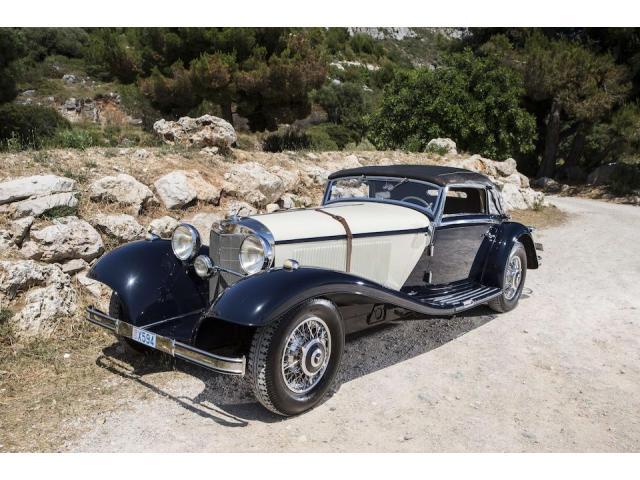1936 Mercedes-Benz 540 K Cabriolet A
- Brand: Mercedes-Benz
1936 Mercedes-Benz 540 K Cabriolet A
Together with its predecessor the 500 K, the magnificent Mercedes-Benz 540 K was arguably the most noteworthy production model offered by the Stuttgart firm during the 1930s. A development of the 500 K, whose independently suspended chassis it shared, the 540 K was powered by a 5.4-litre supercharged straight-eight engine. The 540 K was one of the first models developed under Mercedes' new chief engineer, ex-racing driver Max Sailer, successor to Hans Nibel, who had died in November 1934 aged only 54. It featured the company's famous Roots-type supercharger system in which pressing the accelerator pedal to the end of its travel would simultaneously engage the compressor and close off the alternative atmospheric intake to the carburettor. This system had been thoroughly proven on the preceding series of Dr Porsche-conceived S-Type cars, and in effect the 540K was the last supercharged production Mercedes until relatively recent times.
Launched at the Paris Salon in October 1936, the 540 K had an engine that developed 115bhp un-supercharged or 180bhp with the compressor engaged. The gearbox was a four-speeder, but with a direct top gear rather than the overdrive ratio used on the earlier 500K. With the supercharger engaged, the 540 K's blown straight-eight gave it a top speed approaching 110mph (177km/h) matched by servo-assisted hydraulic braking. Its performance potential was such that Mercedes-Benz in the UK retained racing driver Goffredo 'Freddy' Zehender as technical adviser and demonstration driver, since the super¬charged Mercedes was one of the few genuine 100mph road cars available in the 1930s.
Late in 1938, a revised 540 K made its appearance, with oval-section chassis tubes instead of channel frame members, while the adoption of sodium-cooled valves followed the company's highly success¬ful racing practice.
Although the 500 K/540 K chassis attracted the attention of many of the better quality bespoke coachbuilders of the day, the company's own Sindelfingen coachwork left little room for improvement. The cabriolet came in a variety of styles. This example has the desirable Cabriolet A option with two-door, left-hand drive coachwork and is outstandingly handsome. The work of the gifted Hermann Ahrens, design chief at Mercedes-Benz's in-house Sindelfingen coachworks, the Cabriolet A offered two-seater accommodation allied to breathtaking performance.
The manufacturing record of the 540 K revealed its exclusive nature: 97 being produced in 1936, 145 in 1937, 95 in 1938 and 69 in 1939 before the war ended series production (though three more were built up to July 1942). In recent years, the rarity, style and performance of these big supercharged Mercedes have made them one of the most sought-after of all classic cars on the few occasions they have come on the open market.
This ultra-rare 540 K Cabriolet A, chassis number '130946', has been confirmed by Mercedes-Benz to be one of a mere ten cars that left the factory built to its particular 'interim' specification: equipped with the more powerful 5.4-litre engine but carrying the 500 K-style body with two rear-mounted spare wheels (see fax from Daimler Chrysler AG on file). This sporting body style is similar to that of the exclusive 540 K Special Roadster and thus is one of the most sought after of all factory coachwork.
'130946' was ordered on 3rd June 1936 (internal order number '226106') and its bodywork completed at Sindelfingen's factory on 13th July that same year. The car was collected by its first owner on 12th October 1936 from the Mercedes-Benz showroom in Paris. Proprietor of the well-known Parisian night-club Bar Americain 'La Roulotte', he is depicted in an archive photograph posing with his Mercedes-Benz outside the premises, which hosted artists of world renown including Edith Piaf and Django Reinhardt. The car remained in his possession for over 70 years and only passed to the current (second) owner in 2007; it is understood that it has never left French soil since being delivered new to Paris. It retains all of its original major components: chassis, engine and bodywork.
In 1993 a meticulous restoration to the highest standards was carried out at the original owner's request by renowned restorer Dominique Tessier of Chambray-Lès-Tours, France.
Descriptions & pictures by bonhams
| Specification | |
| Production Start | 1936 |
| Country of origin | Germany |



























